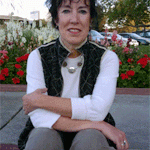
Annie Calkins
Arts Learning Across the Tundra
Posted by Sep 24, 2009 2 comments

Annie Calkins
The Lower Kuskokwim School District in western Alaska is a huge (22,000 miles) network of small, K - 12 village schools ranging in size from 40 to 800 in Bethel, the district hub. Schools are accessible only by small plane or snow machine, depending on the time of year and weather conditions. The city of Bethel has a population of 5,800, and five schools. Excluding Bethel, 99.5% of the population of the District is Native Alaskan and Yup'ik is the primary language in these communities. There are no Arts Specialists in the district, and no formal arts curriculum, though there is a vibrant Yup’ik culture and language program which incorporates indigenous art forms practiced for generations and passed on by respected Elders.
The distrtrict operates a district-wide Title One Program, as it is one of the most poor of rural Alaska districts; 87% of the total student population are Title One students. Though it has an average childhood poverty rate of 64%, eighteen village schools have over 80% of their students living in poverty. Children come to school speaking Yup’ik and use it as the language of instruction through third grade.
Young LKSD students are generally Not Proficient in reading and writing on state tests given beginning at the end of third grade. They also generally tend to catch up and in some cases outperform their monolingual peers by the end of 8th grade. Four years ago the district embarked on a serious journey to improve literacy achievement and student attendance and motivation by integrating the arts across the curriculum in ten of the district’s 27 schools.
An interesting feature of the Arts Literacy Project has been the regular use of VTC- Video Telecommunications – as a vehicle for community building, communications, professional development, and, beginning this fall, instructional in the Visual Arts. In the District Office there are two studio rooms which can broadcast and receive simultaneous communications from village sites. In a way it is “Skype writ large”. From the Bethel studio screens – of two large television sets – you can see yourself and whoever/whatever is with you there on one screen and up to six sites in smaller windows on the second screen. As someone speaks from a remote site their face comes to the forefront for all to see, and all hear what is being said.
Agendas and documents are broadcast through the use of Elmo projections. Student art samples and photographs are similarly displayed. So when the winds are raging across the tundra and the temps are plummeting and everyone is feeling quite isolated this technology holds schools and teachers and students together in the transformative work of re-inventing their schools.
Sure, everyone wishes we could be together in person hashing out plans or reviewing student work, or learning new strategies for using Reader’s Theater or visual arts kits to promote English literacy. And that does happen throughout the school year and in summer institutes. But we have also come to rely on the VTC link – when a session is scheduled everyone shows up, without excuses about the weather or other commitments. Out on the edge of Alaska and the extreme edge of this country, this “not too current or sophisticated” technology makes a huge difference in terms of increasing access to arts education.

Comments
It is really a testament to the commitment of the folks there on the tundra that they are willing to spend so many hours and resources to getting the arts to all of their children. You've painted a wonderful image of that part of the world. THANKS for sharing.
Cristine
Annie
Using VTC as you describe it so well is itself a creative work. In addition to the actual work with each other, with students , that essential live interaction, the VTC interaction is another dimension of creative work. I am glad you wrote about it. "Holding people together in the transformative work of re-inventing their schools" --that is quite a piece of wonderful work. In a way I think it is art work, that is, it connects us, enlivens the spirit, encourage and supports the creative spirit.